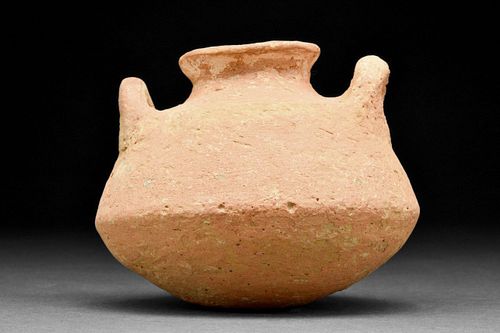A MYCENAEAN POTTERY SQUAT JAR
Lot 53
Categories
Estimate:
GBP£400 - GBP£600
$540.54 - $810.81
Absentee vs Live bid
Two ways to bid:
- Leave a max absentee bid and the platform will bid on your behalf up to your maximum bid during the live auction.
- Bid live during the auction and your bids will be submitted real-time to the auctioneer.
Bid Increments
| Price | Bid Increment |
|---|---|
| GBP£0 | GBP£10 |
| GBP£100 | GBP£10 |
| GBP£200 | GBP£20 |
| GBP£500 | GBP£50 |
| GBP£1,000 | GBP£100 |
| GBP£2,000 | GBP£200 |
| GBP£5,000 | GBP£500 |
| GBP£10,000 | GBP£1,000 |
| GBP£20,000 | GBP£2,000 |
| GBP£50,000 | GBP£5,000 |
| GBP£100,000 | GBP£10,000 |
| GBP£200,000 | GBP£20,000 |
| GBP£1,000,000 | GBP£50,000 |
About Auction
By Apollo Art Auctions
Jan 16, 2022
Set Reminder
2022-01-16 08:00:00
2022-01-16 08:00:00
America/New_York
Bidsquare
Bidsquare : Ancient Art & Antiquities
https://www.bidsquare.com/auctions/apollo-art-auctions/ancient-art-antiquities-8043
Apollo Art Auctions enquiries@apolloauctions.com
Apollo Art Auctions enquiries@apolloauctions.com
- Lot Description
Circa 1500 BC. A pottery jar with narrow globular base, a wide body with lightly corseted walls, a sloped shoulder with a pair of arching handles, and a squat, tapered neck with a flared rim. CU Art Museum Accession Number: 2006.17.T, Mycenaean Squat Jar Chara Tzavella-Evjen, Greek and Roman Vases and Statuettes from the University of Colorado Collection (Athens: Archaiologikon Deltion, 1973): 192-197. Dates from John G. Pedley, Greek Art and Archaeology (Upper Saddle River, N.J.: Prentice Hall 1993): 29. Arne Furumark, The Mycenaean Pottery: Analysis and Classification (Stockholm: Victor Pettersons Bokindustriaktiebolag, 1941): 1, 39. For a full description of the alabastron shape, see Andrew J. Clark, Maya Elston, and Mary Louise Hart eds., Understanding Greek Vases: A Guide to Terms, Styles, and Techniques (Malibu: J. Paul Getty Museum, 2002): 65; see also Brian A. Sparkes, Greek Pottery: An Introduction (Manchester and New York: Manchester University Press, 1991): 80; Edward Lucie-Smith, The Thames & Hudson Dictionary of Art Terms ( New York: Thames & Hudson, 2003), 12. Furumark, The Mycenaean Pottery:1, 422. Furumark, The Mycenaean Pottery: 1, 423. Reference Chara Tzavella-Evjen, Greek and Roman Vases and Statuettes from the University of Colorado Collection (Athens: Archaiologikon Deltion, 1973): 192-197.Size: L:85mm / W:95mm ; 180gProvenance: Property of a UK Ancient Art Gallery, formerly in the Collection of Mr. and Mrs. Robert Feuer, NY., acquired 1970s - 1980s.
- Shipping Info
-
We offer in-house packing and international shipping at discounted rates.
-
- Buyer's Premium



 EUR
EUR CAD
CAD AUD
AUD GBP
GBP MXN
MXN HKD
HKD CNY
CNY MYR
MYR SEK
SEK SGD
SGD CHF
CHF THB
THB















